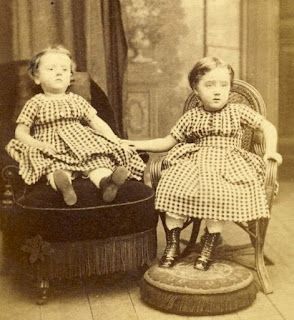

This was my first encounter with "postmortem photography".
The invention of the dagguereotype in 1839 allowed those who couldn't afford a painted portrait to have a lasting image of family and loved ones. Death in Victorian times was an ever-present reality, especially since infant and child mortality was incredibly high. A photograph of the deceased might be the single lasting visual memento; the body, posed with living members, the only "family group" photo that would ever exist. It wasn't considered macabre, or even unusual. Prints might be sent out to family and friends unable to attend the funeral rites.
Dr. Stanley B. Burns, a New York City opthamologist, established something called The Burns Archive in 1977. The archive is a trove of photos and information on the darker side of medicine including anatomical and medical oddities, post-mortem photography, and photographs of death, disease, disaster, and war. Dr. Burns authored Sleeping Beauty: Memorial Photography In America , a comprehensive and exhaustively researched collection of post-mortem photography.
Post-mortem photography served a purpose at one time. In today's era of digital cameras, cellphones with photographic ability - heck, even my toddler granddaughter's LeapPad toy can take pictures - I didn't think that anyone would ever dream of taking pictures of dead people.
I am always willing to keep an open mind, approach any topic, and change my opinion. During a discussion with friends, someone brought up situations that I hadn't considered. What about the parents of a child who was stillborn? They would have no other option if they wanted an image of their beloved child. Is it really so awful to take a photograph at life's end, to complete the circle? Should we take our cue from earlier generations and move back toward making death an accepted and natural part of life? Is postmortem photography creepy, sad, or another way to hold on to departed loved ones for just a little while longer?



When my grandmother died in 1988, we took a photograph of the body in the coffin. While I don't think it's creepy, it's a set of photographs that I'd rather not look at again. It makes me sad. I'd rather look at photographs of her being happy.
ReplyDeleteThat said, I know of someone who hired a whole camera crew and filmed his mother's funeral. It was way too much for me but he felt he was honouring his mother.
Ultimately, I think this is a personal choice. Some may be able to handle it. Some others not.
A thought-provoking post, nonetheless.
Aneeta from
How to Tell a Great Story
It is absolutely a personal choice, as well as a family's (and maybe even cultural) choice. And as my parents pointed out during a discussion, in the US death seems to have become sanitized and far removed from everyday life compared to even 75 years ago. When they were young it was still the custom to lay out the body in the parlor and invite everyone over, including the children. I suppose part of my problem is that I really hadn't any direct exposure to death (aside from animals)until I was in high school.
DeleteActually, I think you need to take a serious look at how you view death. But then I took a picture of my Mom on her deathbed and though nothing of it.
ReplyDeleteAs I said above, I'm perfectly willing to do that. Most of my ill-feeling at the family member's viewing is that our wishes were being blatantly disregarded by one person, and I am very big on respect. And I certainly don't want to appear disrespectful of anyone else's feelings, beliefs, etc.
DeleteYour very interesting post has taught me something about the Victorians that I knew nothing about. I can understand why it happened back then, but in this day and age the idea is beyond me. I wouldn't dream of taking a photo of one of my family members after they had died.
ReplyDeleteSusan A Eames from
Travel, Fiction and Photos
Your very interesting post has taught me something about the Victorians that I knew nothing about. I can understand why it happened back then, but in this day and age the idea is beyond me. I wouldn't dream of taking a photo of one of my family members after they had died.
ReplyDeleteSusan A Eames from
Travel, Fiction and Photos
I'm glad that you learned a bit, and it's interesting reading everyone's different reactions and viewpoints!
Deleteplay bazaar
ReplyDeleteActually, I think you need to take a serious look at how you view death. But then I took a picture of my Mom on her deathbed and though nothing of it.